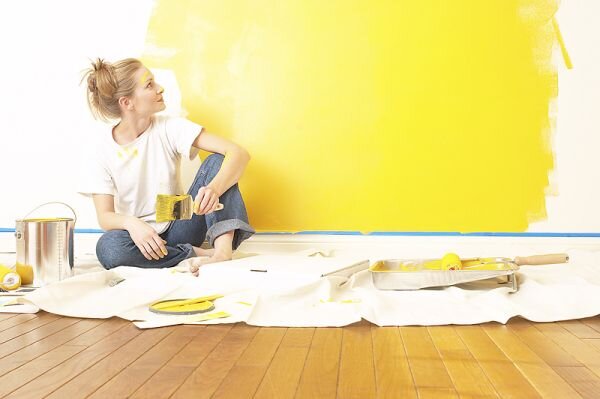Painting a room is an exciting prospect that can change the entire look of the space. But knowing where to start can be daunting when you’re staring at row after row of paint cans or color chips. This guide will walk you through the process to creating a pro paint job.
Project Scope
The first thing you’ll want to plan is the project scope. It can be easy for project scope to “creep” once you’re in the store looking at all of the fabulous color choices. Suddenly you’ve planned to repaint every room in the house, regardless of time or cost constraints. Be sure to plan out exactly which projects you’re aiming to complete so you don’t get off track.
How to Pick a Color?
This is probably the most fun part of painting, but also one of the most trying. Choosing the exact right color is time-consuming, and requires effort and thought. Here are some tips to choose a color you’ll love for years.
Start with Chips: Start with paint chips to get a sense of the colors you’re looking for. Bring them home and tape them on the wall or stick them behind trim, and live with them for a few days. Your eye will generally start to gravitate toward one color range. Chips are also useful for comparing with furniture upholstery, draperies and the like to make sure they all coordinate.
Move on to Samples: Once you’ve decided on a color family, choose three to five shades you want to test on the wall, and order samples. Be sure you prime the wall if you’re going to be painting over another color. Again, living with these samples on the wall for a few days is a great way to see which one keeps your attention.
Check with Lighting: It’s important to check samples during the day and with different lights. This makes such a huge difference in the tone of the color, which you may love at dusk but decide feels garish at 7 a.m.. Don’t forget to consider the effects of your internal lighting (all floor lamps, overhead lighting, etc.) when you have samples on the wall as well.
Paint Type: Latex vs. Oil
Latex paint is water-based, making clean-up much easier. Since it is water-based, it can go right down a standard drain with soap and water. It dries faster and doesn’t yellow over time, making it ideal for most projects. Chances are, for most applications you’ll want to choose latex paint.
Oil-based paint is thicker and smoother, but requires more drying time and special precautionary and clean-up measures. You’ll want to wear a mask while you work, and the paint and solvents used to clean it are considered hazardous waste by many communities and can’t be thrown away directly.
Different Types of Finish
The finish might not be on your radar, but it should. Certain rooms and areas will benefit from different finishes of paint, so you’ll want to be sure you’re getting the best one for your application. Here’s a quick rundown of the options that are available and how to utilize them.
Flat: Flat paint is matte and has no sheen. This makes it easy to hide flaws since it isn’t drawing light to any trouble spots. The downside is cleaning: matte paint is not wipe-able so it’s not great for high-traffic areas. This is generally a specialty paint that works well in less-used spaces.
Satin/Eggshell: The standard for most areas. It’s easy to clean, not too shiny, and lasts well.
Semi-gloss: Semi-gloss has a moderately shiny finish that is neither matte nor eye-catching glossy. This makes it even easier to wipe clean with a simple cloth, and gives it a beautiful finish. Trim and woodwork benefit from a semi-gloss that stands out from the satin wall.
High-gloss: The name says it all: this is a very high-shine paint. Since it attracts the eye and light, it is best used for highlighting trim or in areas that see a lot of moisture and can benefit from the durability and easy cleaning of high-gloss paint. It is the smoothest, but also shiniest, of the bunch.
Paint Costs
Paint is expensive, there’s no getting around it. Shelling out for high-quality paint is a worthy investment, though, because the walls are something you live with daily, and flaws will distract your eye.
When shopping, have some basic numbers on hand: know your square footage, the price of the paint, and how much square footage a gallon of that type covers. Keep in mind that less expensive paint may require two coats, and a more expensive all-in-one paint may let you skip a primer. Don’t forget to factor in ceilings, doors and trim.
By Natalie Wise on 5/19/2016

